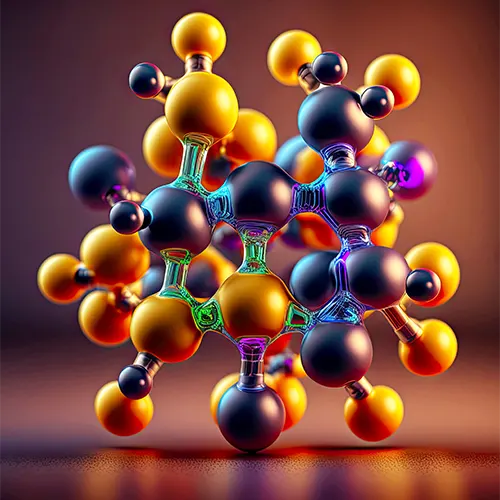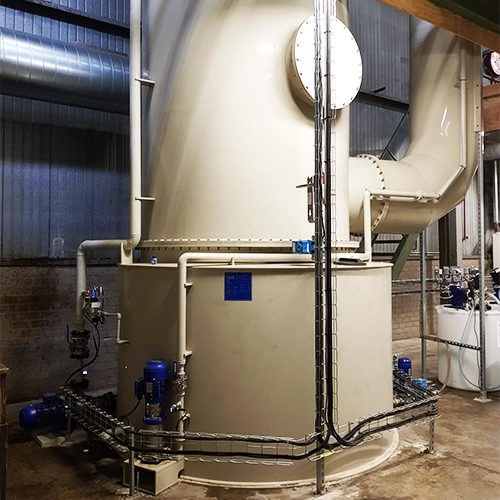
Cyanides: Vital, Hazardous, Manageable
Sustainable Innovation and Safety Hand in Hand
Customised advise from one of our specialists.
Fill in the form below and we will contact you as soon as possible.

Understanding Cyanides: Composition and Applications
The Dual Nature of Cyanides: Toxicity and Utility

The group of cyanide-containing substances consists mainly of hydrogen cyanide (HCN, hydrocyanic acid), the potassium salt of hydrocyanic acid (KCN, cyanide), and the calcium salt (Ca(CN)2, calcium cyanide).
Hydrocyanic acid, also known as hydrogen cyanide, is a highly toxic substance found in nature. Cyanide is a toxic chemical commonly utilized in the chemical and metal industries. Historically, cyanide was employed in mining to extract valuable metals like gold and silver from ore. Despite its negative reputation, cyanide also possesses beneficial properties and serves as a key ingredient in numerous everyday products. For instance, it is utilized in the production of vitamins and medications for conditions such as high blood pressure. However, it is crucial to note that cyanide is only present during the manufacturing process and is not retained in the final products, ensuring their safety for use. Furthermore, cyanide is released during the combustion of PVC and various plastics, as well as being present in vehicle emissions.

The Toxicity of Cyanides and Human Exposure
Cyanide in Daily Life: Risks and Body's Defense Mechanisms

Cyanide is a highly toxic substance to humans as it interferes with the processes in the mitochondria of cells, which are crucial for energy regulation. This disruption leads to a rapid halt in the energy and oxygen balance within the cells, resulting in immediate symptoms.
Small amounts of cyanide are consumed by humans daily, whether through food (such as cassava, which contains a substance that converts into cyanide in the body) or through cigarette smoke. Fortunately, the body has the ability to convert cyanide back into a harmless substance in the liver. In some cases, signs of chronic poisoning may manifest. However, when a large quantity of cyanide enters the body at once, the body is unable to detoxify it, leading to symptoms of acute (severe) poisoning.
Despite cyanide or hydrocyanic acid gas having an almond-like smell, not everyone can detect it due to a genetic defect.
Get in touch with us

Industrial Uses of Cyanide in Mining and Manufacturing
The Critical Role of Cyanide in Gold Extraction and Electroplating

Hydrogen cyanide (HCN) finds its applications in various industries such as paper, nylon, plastic, textiles, and fumigants. In the mining and metals sector, HCN is utilized for the production of sodium cyanide (NaCN) and potassium cyanide (KCN). These compounds play a crucial role in the electroplating process of gold and silver.
Cyanides play a crucial role in the extraction of gold from rock in gold mines. They are also utilized in the mining and purification of precious metals. The fine dust present in the spent ore of a gold mine can be dissolved in a solution of hydrocyanic acid and then precipitated by adding zinc powder. Many prospectors actively employ cyanide in their search for gold. Despite its toxicity, cyanide can be rendered non-toxic under specific conditions and concentrations. Cyanide is indispensable for mining commercial gold and is currently considered the safest option within the gold industry, as other alternatives pose greater risks to the environment and human health, according to experts. Gold ore is extracted from the soil using high-pressure water jets or by pulverizing the rock. It is not so easy to extract gold from the raw ore and then purify it. The extraction and purification of gold from its raw form is a challenging task. This is primarily due to the metal's low solubility and limited reactivity with most compounds. The most commonly employed method involves the reaction of gold with sodium cyanide, oxygen, and water. The resulting compound, Na[Au(CN)2], is collected using activated carbon and then transformed back into metallic gold through electrolysis. Throughout this process, significant quantities of sodium hydroxide are released. However, the cyanide process used in gold extraction is highly controversial due to the substantial waste it generates, with 18,000 kilograms produced for a mere ten-gram gold ring. Moreover, sodium cyanide is extremely toxic and has already caused leakage issues in various mining operations.

Cyanides in Electroplating and Beyond: Diverse Applications
Challenges and Innovations in Cyanide Detoxification

Cyanide is used in electroplating baths for copper and silver deposition and in a number of chemical syntheses of raw materials for plastics. Cyanide plays a crucial role in the electroplating process, despite its negative connotations. Its presence guarantees a uniform deposition of metals onto the galvanized part. During the rinsing stage, the cyanide is effectively removed. Nevertheless, detoxifying the cyanidic wastewater from the rinse baths poses a significant challenge. To address this, both free and bound cyanide are oxidized in an alkaline environment, facilitated by the addition of NaOH and NaOCl. It is imperative to closely monitor this process to prevent any detrimental side reactions.
Furthermore, cyanides find applications in the metal industry, jewelry industry, and photography. Historically, cyanides have been employed for the purpose of rat and insect control as well.

Hydrocyanic Acid: A Pillar in Green Chemistry and Biochemical Applications
Navigating the Hazards: Safety Measures for HCN Use

Hydrogen Cyanide (HCN), also known as hydrocyanic acid, finds numerous applications in the (bio)chemical industry. It serves as a crucial C-1 building block, providing a raw material with a single carbon atom. This carbon atom plays a significant role in the synthesis of various substances, including beta-blockers for blood pressure reduction, plastics, and dietary supplements like vitamins and essential amino acids. From the perspective of green chemistry, the utilization of HCN aligns with the fundamental principles of sustainability and can contribute to more environmentally friendly (bio)catalytic processes. Despite its cost-effectiveness and minimal residual byproducts during synthesis, hydrocyanic acid poses a severe health hazard. Exposure to its gaseous form can be fatal for both humans and animals. Consequently, stringent safety regulations and precautions, such as extraction systems, detection equipment, and strict workplace protocols, are imperative for the transportation and handling of this toxic substance in both industrial and research settings.
Chemical reactions in chemistry can result in the release of hydrogen cyanide gas. One such reaction occurs during the production of top-notch filter material. Autoclaves are used to fill foam blocks with a mixture of hydrogen and oxygen. By initiating a controlled explosion, the cell walls of the foam are blown out, creating an open structure. This open structure makes the foam an ideal base material for high-quality filters. However, a drawback of this process is the release of hydrogen cyanide gas, which needs to be removed before the gas can be emitted. The reticulated foam produced through this process serves as the foundation for various products. It is utilized as a semi-finished material in advanced impregnated air filters, fine-cell filters for electric car batteries, and ceramic filters for metal casting.
Game-changing benefits
Discover the game-changing benefits of scrubbers and propel your business forward with our free whitepaper download.

Advanced Solutions for Cyanide Removal in Gas Flows
The Efficacy of Open Spray Scrubbers in Detoxification

Removing cyanides from a gas flow is a major challenge, as they are sometimes very difficult to eliminate. However, it is first necessary to determine what the load is and which components need to be removed in view of the configuration of the scrubber. A cyanide gas scrubber therefore almost always consists of a combination of several processes: an oxidative treatment, an alkaline treatment and often a neutral cleaning with water. These sections can be used separately or in combination with each other.
Ravebo's open spray scrubbers function by utilizing the disparity in velocity potential between the liquid droplets and the gas entering the system. The liquid is released through nozzles at a moderate pressure to achieve a uniform distribution of droplets and an even spray pattern. The size of the droplets is crucial, as ultrafine droplets possess a significantly higher surface-to-volume ratio. These extremely fine droplets generate a fine mist, enabling effective particle capture. The spray absorbers operate in a relatively straightforward manner, requiring minimal maintenance and incurring relatively low energy expenses. The scrubber operates using a closed-loop pump system, where the washing liquid is pumped from the buffer. This is done based on the measurement values obtained from the gas analyzer.
The spray system is comprised of several detachable spray lances equipped with spray nozzles, with a combination of co-current and counter-current designs. The precise placement of these spray nozzles within the scrubber is crucial for effective gas treatment, as they effectively capture particles due to the close interaction between the washing fluid and the process gas. The specially designed nozzles, which are resistant to clogging, produce fine droplets with a uniform spray pattern, maximizing the capture of dust and gas particles. By ensuring optimal contact between the fine liquid droplets and the gases and dust particles, a significant absorption of pollutants can be achieved.
Due to the lack of random packing or a structural packing, the open spray absorbers have a minimal pressure loss and are virtually insensitive to contamination, which normally causes a larger pressure difference. The spray system consists of multiple removable spray lances with spray nozzles, some of which are co-current and some of which are counter-current. The positioning of these spray nozzles in the scrubber is of the utmost importance for optimal gas treatment because they capture particles because of the intensive contact between the washing fluid and the process gas. The clogging-free tangential nozzles create fine droplets with a homogeneous spray pattern to capture as many dust and gas particles as possible. Optimal contact of fine liquid droplets with gases and dust particles will lead to a high absorption of polluting particles and gases.

Innovations in Gas Analysis: The Role of FTIR Spectroscopy
Unveiling Molecular Secrets with Fourier Transform Infrared Technology

Infrared spectroscopy operates on the principle that molecules possessing a significant dipole moment are capable of absorbing infrared light. This absorption of energy prompts movement among the atoms within the molecule. The degree of absorption is influenced by various factors, including the number of atoms in the molecule and the type of bond between them. Each molecule possesses distinct characteristics that dictate the frequencies at which it absorbs infrared energy.
When confronted with gas mixtures containing multiple components, both known and unknown, Fourier Transform Infrared (FTIR) proves to be an exceedingly precise technique for identifying and quantifying the components that absorb infrared radiation. The Gasmet FTIR analyzers employ sophisticated software that can analyze up to 50 components simultaneously, providing comprehensive and dependable results in real time. This stands in contrast to NDIR, which solely focuses on a single wavelength.
The FTIR spectrophotometer operates based on the principles of light behavior. In this instrument, a broad spectrum of infrared frequencies is directed towards a semi-transparent mirror simultaneously. Half of the light passes through the mirror, while the other half is reflected at a 90-degree angle. The reflected light then interacts with either the initial mirror or a movable second mirror, whose precise position is determined by a laser. As the light progresses, it experiences reinforcement and extinction. Upon reaching the semi-transparent mirror again, the reflected light rays interfere with each other, forming an interference pattern that is detected by a sensor. This pattern of interference offers valuable insights into the composition of the substance being analyzed.
The interferogram is analyzed by plotting the position of the second mirror against the intensity detected, and then undergoing a numerical Fourier transform. This transformation helps in identifying the specific waves, along with their frequencies and amplitudes, that constitute the interferogram. The data obtained is visually represented as a transmission spectrum, showcasing the frequencies of the waves.
For more information about Cyanide removal see our HCN Scrubber.
Get in touch with our scrubber specialist
Our gas scrubbers with analyzing systems make it possible to clean various gas flows. This leads to a cleaner living environment and more sustainable production processes. Curious about the possibilities? Our specialists are happy to provide you with appropriate advice.
